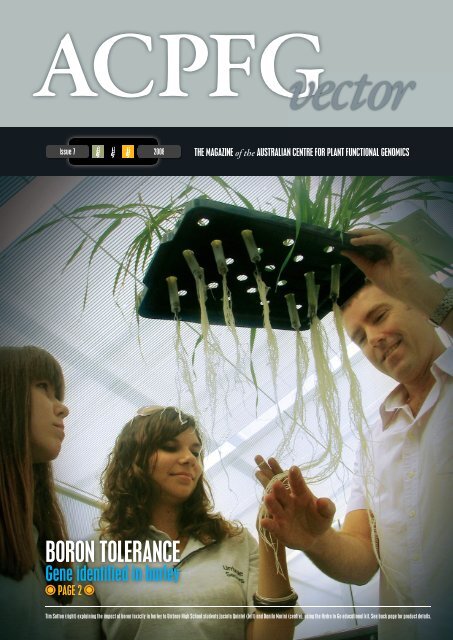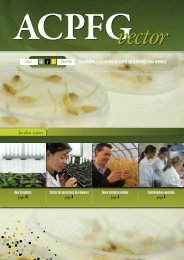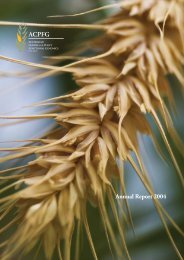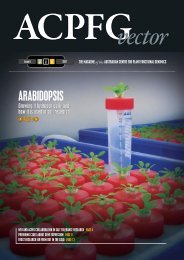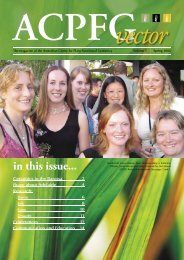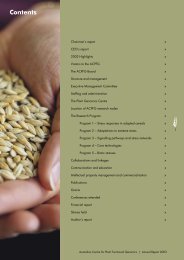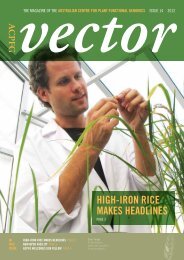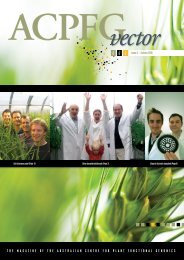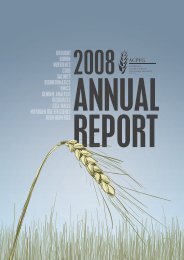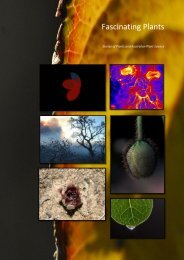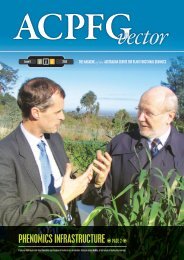Issue 7 2008 - acpfg
Issue 7 2008 - acpfg
Issue 7 2008 - acpfg
- No tags were found...
You also want an ePaper? Increase the reach of your titles
YUMPU automatically turns print PDFs into web optimized ePapers that Google loves.
ACPFG vector<strong>Issue</strong> 7<strong>2008</strong>THE MAGAZINE of theAUSTRALIAN CENTRE FOR PLANT FUNCTIONAL GENOMICSBORON TOLERANCEGene identified in barleyPAGE 2Tim Sutton (right) explaining the impact of boron toxicity in barley to Urrbrae High School students Jacinta Quintel (left) and Danila Marini (centre), using the Hydro to Go educational kit. See back page for product details.
ACPFG VECTORQUANTITATIVE TRAIT LOCIare regions of a chromosomewhere there are stretchesof DNA that scientists havelinked to a particular trait,such as boron tolerance.Boron tolerance geneBY COBI SMITHRESEARCHERS AT ACPFG haveidentified a gene that provides borontolerance in barley. Boron toxicitylimits crop production in Australiaand is the target of an ACPFG Focus Group, led by Tim Sutton.Identification of the Bot1 gene was revealed in the journal Science(30 November 2007).Since the early 1980s scientists have known about the toxic effectsof boron on cereal crops in southern Australia. Bot1 helps barleyplants survive in soils containing high amounts of boron, which isa common problem in Southern Australia, Asia and Africa. ACPFGresearchers identified the gene in the barley landrace Sahara 3771(Sahara), which comes from Algeria.‘Highly boron-tolerant barley landraces had been previouslyidentified, but nothing was known about the molecular basis of theirtolerance,’ Tim said.The ACPFG work built on that of other researchers who had crossedSahara with an Australian barley variety used to make malt, calledClipper, which is sensitive to boron. Mapping tolerance in the plantsresulting from this cross led scientists to identify quantitative trait loci(QTL) for boron tolerance.Tim and his colleagues were then able to use map-based cloningto identify the gene responsible. They used knowledge of similarregions in the rice and Brachypodium genomes to narrow in on theBot1 gene in barley.Once they had pinpointed the Bot1 gene they thought was responsibleidentified in barleyfor boron tolerance, they compared its activity in different barley varieties.They found that there were more products of this gene in Saharathan in intolerant barley varieties. More tests indicated that Sahara hadabout four times more copies of the gene than the intolerant varietyClipper. Curiously, the amount of the gene products in Sahara wasfar in excess of that expected from four copies of the gene, givingresearchers a puzzle to work on in future.Sahara’s boron tolerance is linked to a transporter preventing the entryand accumulation of boron in the plant roots. Tim and his colleaguesconfirmed this is how Bot1 works by doing tests in yeast, then lookingat how the gene was expressed in different parts of barley plants.The paper in Science is called ‘Boron toxicity tolerance in barleyarising from efflux transporter amplification’, by Tim Sutton, UteBaumann, Julie Hayes, Nicholas C. Collins, Bu-Jun Shi, ThorstenSchnurbusch, Alison Hay, Gwenda Mayo, Margaret Pallotta, MarkTester and Peter Langridge.In the field, boron toxicity appears in the tips of the older leavesfirst, turning them yellow with characteristic brown spots. It then extendsdown the leaf as toxicity increases until it causes tissue deathand eventually plant death.Barley is mostly used in Australia to make beer, but is also in healthfoods and confectionary.2InsideNitrogen research gets the nod 3Summer scholar reports 6Get into Genes goes live and local 7Canadians consider Australia’s funding model 8ABSA event 10Australia-China exchange 11Congratulations 12Support for women to break the glass ceiling 13New faces 14
ISSUE 7 – <strong>2008</strong>Bioinformatics researchers at Universityof Queensland (UQ) recently received anARC grant to sequence crop genomes.Grant for sequencingcrop genomesACPFG RESEARCHERS IN UQ’s School of Land, Crop and FoodScience, in association with the Institute for Molecular Bioscience,will look at sequencing the DNA of crop genomes, to determinehow they affect crops’ ability to withstand environmental factorssuch as drought, poor soil and climate change.Many crop genomes are large, complex and contain significantproportions of repetitive DNA, so it can be difficult to make senseof data produced by the latest sequencing methods.The grant will allow researchers to develop and validate anew strategy for sequencing, assembling and annotating complexgenomes, using the Brassica genome as a model.Once established, this strategy could be applied in thesequencing of the genomes of other important crops. Neitherwheat nor barley has been sequenced yet.David Edwards from ACPFG in Queensland said that ‘identifyingthe differences in DNA sequence that enable a crop tosurvive and grow in poor soil or during severe droughts will helpsecure our future food supply.’‘By identifying which sequences are responsible for plantsability to withstand Australia’s harsh environment, we can ensureour main production crops such as wheat and canola willremain viable,’ he said.The Institute for Molecular Bioscience at the University of Queensland3
ACPFG VECTORitrogen Researchgets the nodBY TREVOR GARNETTTHE AUSTRALIAN RESEARCH Council recently awarded Adelaideresearchers a grant to investigate nitrogen use efficiency (NUE) incereal crops.Increased NUE in crops could lead to lower amounts of appliednitrogen fertiliser. Cereal crops are poor at using fertiliser nitrogen,so besides wasting farmers’ money, this has consequences for theenvironment. What the crops don’t use ends up in our rivers andcauses damage to marine environments. Unused nitrogen fertiliseralso becomes a greenhouse gas, with 300 times the global warmingcapacity of carbon dioxide. Also, production of nitrogen fertiliserinvolves greenhouse gas production, so any reduction in fertiliserdemand will reduce this impact.Brent Kaiser from the University of Adelaide and ACPFG’s MarkTester led the NUE funding application. The research involves collaborationwith DuPont’s subsidiary company Pioneer Hi-Bred in theUS, which is also funding the project.“Initially we are focused on maize, which is the top cereal in termsof global production and inefficient nitrogen use. What is learned frommaize will then be applied to wheat and barley,” Brent said.To speed up the maize research, the NUE groupare using dwarf maize plants. These dwarves, as wellas being smaller than normal corn, have a shorterlifecycle, so experiments can be done more quickly.Early experiments have characterised nitrogenfluxes and expression of nitrogen transporters overthe lifecycle of the plant. Results of this researchwere presented at the Nitrogen 2007 conference inLancaster, UK by NUE group members Trevor Garnettand Vanessa Conn.This research relies on being able to grow plants under controllednitrogen supply. ACPFG’s Robin Hosking helped the NUE group todevelop a hydroponic system in a controlled environment growth roomthat can grow over 1000 plants under constant nitrogen nutrition. Thissystem can grow dwarf maize and other cereals such as wheat andbarley to maturity.Other maize work at ACPFG is investigating nitrogen transportprocesses in a range of inbred maize lines that show differences inNUE. This work is more difficult as these plants grow to be about 10times larger than the dwarf maize and their lifecycle takes almost twiceas long to complete. The plants need to be moved around becausealthough some studies can be done in the growth room on four week-old plants, others require anotherhydroponics system inthe glasshouse.An exciting part of theproject, which complementsthe work with cereals, is investigatinghow the overexpressionof specific cell typesaffects nitrogen transportersin Arabidopsis. This work usesGal4 enhancer trap tions developed at the University of Cambridge by Jim Haseloff. Thepopula-Arabidopsis plants, being so small, require yet another hydroponicssystem and, again in collaboration with Robin Hosking, the NUE teamhas developed a system that can grow large numbers of Arabidopsisunder controlled nitrogen supply.‘What the crops don’t use ends upin our rivers and causes damageto marine environments.’4
ISSUE 7 – <strong>2008</strong>Brent Kaiser (front) and Trevor Garnett (back) work withmaize plants in the glasshouse (left) and growth room (below)5
ACPFG VECTORSummar scholar Jade Forresterwith her supervisor, Delphine FleuryI AM REALLY GLAD I CHOSE TODO MY SCHOLARSHIP AT ACPFG,SINCE THE ATMOSPHERE WASSO FRIENDLY AND RELAXED. ALLTHE PEOPLE WERE VERY HELPFULAND ALWAYS HAD A FRIENDLYSMILE OR HELLO IN PASSING.WheatbeatsbloodBY JADE FORRESTERI CHOSE TO DO a summer scholarship at ACPFG to gain some insightinto genetic research in plants, and to make contacts for the future.When I started the scholarship I had no idea what I would be doingand how much independence I would have. Once I was shown sometechniques I was given a fair amount of freedom – I worked on my ownproject, but I still received guidance and help when needed.I thoroughly enjoyed my time at ACPFG and it has made me wantto pursue the genetics field further. I have always enjoyed genetics, butI don’t like blood. So I was forced to go into plant research if I wantedto continue in the genetics field, however throughout my scholarship atACPFG, I realised that plants are so much more diverse and interestingthan humans. I learnt quite a lot about wheat and its origins duringthe scholarship and various techniques that aren’t possible on mostanimals due to their type of genomes.I am really glad I chose to do my scholarship at ACPFG, since theatmosphere was so friendly and relaxed. All the people were veryhelpful and always had a friendly smile or hello in passing.My advice to other people interested in applying for a summerscholarship is to give it a go, and just be yourself. I think trying for ascholarship is great as you can see what the industry is like and whetheror not you really want to continue in your field of interest. Also, if yourealise that it isn’t really for you, it doesn’t matter because you gainfriendships with people that will last a long time.6
ISSUE 7 – <strong>2008</strong>Summer student Rebecca McBride (centre) worked with Dr Stuart Roy (left) and PhD student Joanna Sundstrom (right)Support and socialising are ACPFG assetsBY REBECCA MCBRIDEI APPLIED FOR the summer scholarship program at ACPFG becauseI wanted to get experience in a research environment, particularly inplant science, as I am studying Agricultural Science at the Universityof Adelaide.I knew relatively little about the centre before I applied but foundthat the research was very relevant to the major issues facing theagricultural industry, both in Australia and around the world.I was nervous before I started as I had very little experience inlaboratory work but the work was matched to my abilities and whatI was comfortable doing.One of the most interesting aspects was going to lab meetings andjournal club, which provided me with an opportunity to see how thelab was run and research going on around the world.What I didn’t expect was the strong social side to the centre. Duringmy time at the centre I went to a pirate-themed Christmas party and apool party called a ‘lab meeting’. These gave me an opportunity to get toknow the people from the centre away from the work environment.For people who are thinking of applying I recommend that youdo because you get experience in a world class research facility, thework is tailored to your abilities and interests and you get to meetmany friendly people who could be good contacts for a future careerin plant research. All the staff are very helpful and more than happyto have you there.I really enjoyed my time at ACPFG and would like to thankeveryone involved.What I got out of the scholarship:Learnt many new lab techniques actuallybeing used in current research.The opportunity to work with people fromall around the world.Experience using state of the art equipment.Confidence in working by myself and theability to work with many different people.Meeting people from the industry that arepotential contacts for the future.7
ACPFG VECTORGet into Genes goes live and localBY BELINDA GRIFFITHSWITH THE DEPARTURE of Marie Thorpe at the end of 2007, Istepped into the role of Education Officer for Get into Genes (GiG)in Victoria in <strong>2008</strong>. During our handover Marie introduced me tothe head of ACPFG in Victoria, Tony Bacic, from the Universityof Melbourne, who is a great supporter of GiG. I also met JohnPatterson who took me on a guided tour of the ACPFG’s stunninglaboratory facilities.GiG has been able to continue in Victoria this year largely dueto the contribution of funding from La Trobe University. RogerParish, Head of the School of Life Sciences at La Trobe, providesstrong support for GiG. He has been extremely active promotingthe program within the university and to the wider community.The Victorian student demonstrators have given me a greatdeal of support in creating enjoyable and challenging workshopsfor all school students. This year Geraldo Guimaraes (profiled onRoger Parish and Belinda Griffithsthe New Faces page) joined the demonstrating team. He is a greatcommunicator and is doing a fantastic job sharing his passion forscience with the students participating in the program.On April 13th I was interviewed live-to-air about GiG on oneof Melbourne’s coolest community radio stations. I was askedabout the practical activities in the workshops and how studentsfelt about GM. The interviewers, all post-doctoral scientists orscience communicators, were impressed that Victorian secondarystudents were being given the opportunity to engage ‘hands-on’with cutting-edge molecular technologies and agreed that as aresult the ‘decision-makers of tomorrow’ would be better informedabout science and technology in agriculture.Since 2004, GiG has been taken to rural and regional schoolsin Victoria and South Australia, mostly in response to individualteacher requests. The GiG team aims to build on the networksalready established in order to develop a stronger OutreachProgram. Working with ACPFG Education Manager MonicaOgierman and Heather Bray from MPBCRC, I am applying toBiotechnology Australia for funding for this exciting initiative.Regional schools often struggle to access the resources that areavailable to city schools and GiG, with its focus on agriculturalresearch and crop improvement, has particular relevance to ruralstudents considering a career in this sector.8
ISSUE 7 – <strong>2008</strong>THERE ARE MANY PARALLELS BETWEEN AUSTRALIA AND CANADA. I THINK IF YOULOOK AT ISSUES LIKE SIZE, POPULATION, THE ENVIRONMENT AND CROPS THIS ISTHE MOST LOGICAL COUNTRY FOR US TO LOOK AT.CanadiansconsiderAustralia’sfunding modelBY COBI SMITHA GROUP OF Canadian grains industry leaders visited ACPFG recentlyas part of a GRDC-organised Australian tour, to study Australia’s approachto grains research and look for areas in which the two countriescan collaborate.Manager of New Initiatives with the Alberta Crop Industry DevelopmentFund, Allan Hall, said the group was interested in how different researchorganisations and funding agencies in Australia worked together.‘We’re also looking for specific crop genetics projects that we mightundertake jointly with Australia in areas such as drought resistanceand nutrient use efficiency,’ he said.Waite Campus Director and ACPFG Deputy CEO Geoff Finchergave the group a tour of the campus, before they shared lunch withACPFG staff.ACPFG CEO Peter Langridge said the visit was worthwhile. ‘Wehave a lot in common with Canadian researchers, so this visit couldlead to a new collaboration,’ he said.Allen Good, a molecular geneticist with the University of Alberta,was interested in how Australia managed science funding.‘I think that the issue of how you fund science, particularly tomake sure it’s targeted towards real goals that are really going tobenefit the producers, is one that we do not necessarily handle wellin Canada,’ he said.Allen said he hoped that the trip would lead to serious discussion inCanada between federal and provincial funding agencies about whatmodels worked, and how some of the Australian approaches couldbe worked into a Canadian model.‘There are many parallels between Australia and Canada. I think ifyou look at issues like size, population, the environment and cropsthis is the most logical country for us to look at,’ he said.Allen said he was impressed by GRDC’s role in balancing basicresearch and applied research: ‘As challenging as it is, it encouragesdialogue between producers, researchers and private industry,’he said.Geoff Fincher (second from right) shows the Canadian delegation around the Waite Campus9
ACPFG VECTOR‘A great chance to see the different paths you can take to get the job you want!’ SARAH ANDERSON, TAFE SA.‘There’s a whole wide world of biotech out there!’NURULAINI, UNIVERSITY OF ADELAIDE.‘I got information I hadn’t been able to find elsewhere.’ LUCY AUKETT, UNIVERSITY OF ADELAIDE.‘A great chance to talk with people that are experienced and professional.’ PUI LAM, UNIVERSITY OF ADELAIDE‘The speakers inspired me to think of careers in science not necessarily in research.’AMY KOSHELLA, FLINDERS UNIVERSITYABSA event showsstudents life beyond studyBY ANGELO BUETION WEDNESDAY 2 ND APRIL the South Australian branch of theAusBiotech Student Association (ABSA) kick started the year with itswelcome event, ‘Biotech at the Bar’. Almost 100 undergraduate andpostgraduate students convened at the Seven Stars Hotel in Adelaidefor a cosy panel discussion with members of the bioscience community.The event allowed the ABSA SA committee to meet withbioscience students from South Australian universities and TAFE SAand demonstrated how ABSA SA can help them by ‘linking studentswith industry’.This year’s panel consisted of Belinda Barr (Primary Industries &Resources SA), John Terlet (Director, Adelaide Microscopy), RomanaBorowicz (Project Coordinator TGR Biosciences Pty Ltd) and DeirdreZander-Fox (PhD Student, Centre for Reproductive Health/Clinicalembryologist, Repromed). The speakers provided excellent insightinto the dynamic biotechnology industry in SA and highlighted thediversity of options available to bioscience students. Several pointsresonated with the audience, including John Terlet’s advice on therelevance of extra qualifications and Belinda Barr’s enthusiasm formedia communications within the science industry.After the panel presentation the audience were given the opportunityto ask the speakers questions. Students were interested in how to getinto non- research positions, and how working in Adelaide compareswith working both interstate and internationally.The event was a great success. The ABSA SA committee wouldlike to thank each of the speakers and our sponsors, ACPFG (supportingpartner), the University of Adelaide (wine donator), and inparticular our major partner, Adelaide Microscopy, for its continuedsupport in <strong>2008</strong>.TOP LEFT: ACPFG PhD candidate Alexandra Smart, Co-Chair of ABSA SAand MC of the event, with National ABSA Coordinator Olgatina BuccoLEFT: Alexandra Smart and Angelo Bueti drawing prizes10
ISSUE 7 – <strong>2008</strong>Australia – ChinaYoung Scientists Exchange SchemeJacqui with members of Prof. Meng’s lab at the mountain retreat. Prof Meng is behind Jacqui, centreBY JACQUELINE BATLEYIN JULY I HAD the opportunity to travel to China as part of the AustraliaChina Young Scientists Exchange Scheme. The scheme aims to advancethe careers of young scientists by promoting collaboration between thetwo countries. I was among eight Australian participants selected froma range of scientific disciplines. The first day in Beijing involved visitsto three of China’s principal science funding institutions: the ChineseAcademy of Science, the National Natural Science Foundation of Chinaand the Chinese Ministry of Science. These visits provided insights intothe funding process in China, with the revelation that the NationalNatural Science Foundation receives 35,000 applications in the fieldof life sciences, which have to be reviewed within 2 weeks! The reviewprocess is obviously successful as 80% of work which results in Scienceand Nature papers in China is funded through this foundation.Following this introduction, each of the participants went their separateways to visit institutes of their choice across China. My first visit wasto Wuhan to be hosted by Jin Ling Meng at Huazhoung AgriculturalUniversity. Both Meng and I are members of the Multinational BrassicaGenome Project steering committee and this visit was an ideal opportunityto establish more formal links between the two groups. A tour of thelab for Crop Genetic Improvement and a seminar detailing my researchand areas of interest were followed by discussions with key researchersin the group. In an ideal situation for scientific discussion, along withsome sightseeing, I spent the following two days at a mountain retreatwith Prof Meng and 44 members of his group. Following a debriefsession with Prof Meng we agreed on several areas of collaborationand future exchanges are planned.Following Wuhan, I visited Da Luo at the Institute of PlantPhysiology and Ecology in Shanghai. Luo regularly publishes inhigh profile journals such as Nature and Cell, mostly in the areaof legume research. Meeting with Luo provided an opportunityto enhance my knowledge of legume research, as well as gaininspiration from such a high profile scientist. Between the scientificmeetings there was a weekend of sightseeing around Shanghai,including trips to the Bund and a visit to a traditional Chinese village.Overall, the visit was a great opportunity to gain insight into the sciencefunding system in China and explore collaborative research projectswith Chinese research groups. Another group of young Australianscientists will vist China through the scheme in 2009.11
ACPFG VECTORCongratulationsCONGRATULATIONS TO HEAD OF ACPFG IN VICTORIA, TONYBACIC FAA, who was recently elected to the Australian Academy ofScience (AAS). Seventeen of Australia’s leading scientists were honouredon 19 March by election to the academy, in recognition of acareer that has significantly advanced, and continues to advance, theworld’s scientific knowledge.Tony was elected for his work on the structure and biology ofcomplex carbohydrates. Tony was formally admitted as a new Fellowat the AAS ‘Science at the Shine Dome’ meeting from the 4th to the6th of May in Canberra. Tony gave a seminar called ‘Cell walls: theskeleton of the plant world’ at the meeting.CONGRATULATIONS TO ACPFG QUEENSLAND BIOINFORMAT-ICS LEADER DAVE EDWARDS, who recently published a book inJanuary called Plant Bioinformatics: Methods and Protocols, throughHumana Press.Bioinformatics is a rapidly developing field. Data volumes continueto grow and there is an increasing breadth of available data, includingsequence, gene expression, protein, metabolite and phenotypicdata. Novel databases are being developed for specific species orexperiment types. These databases and tools may greatly assist in theapplication of plant biotechnology, though they require a basic set ofskills to identify and utilize the most appropriate resource.This book aims to assist research scientists in choosing themost applicable database or bioinformatics tools to aid and promotetheir research in plant biotechnology. Chapters include practicalexamples and highlight common problems encountered in bioinformaticsanalysis.Further chapters are aimed at researchers developing bioinformaticsdatabases and tools, detailing commonly applied database formats andbiology-focused scripting languages. These will provide both beginnerand experienced bioinformatics researchers with the necessary skillsto develop and apply bioinformatics tools for their specialist area ofplant research.12
ISSUE 7 – <strong>2008</strong>Support for womenSTEPHANIE AGIUS, ACPFG’s IntellectualProperty Manager, has been selected to participatein the Board Readiness Program of theAustralian Women in IT and Science Entity.A critical element of Board effectivenessis diverse and equitable composition. Yet statistics show that womenhold less than 10% of Board memberships. ACPFG is an exception,with two female Board members of five.The Board Readiness Program equips participants with the skillsrequired to become highly effective Board members and allow them toshowcase these skills to South Australian organisations. It was developedby the Women in Technology (WIT) Queensland Association in 2002and has a high placement rate of graduates into board positions.‘This program is a fantastic opportunity for women to learn aboutthe risks and responsibilities of being a non-executive director,’Stephanie said.During the five month program, she will attend various workshops runby speakers including lawyers from Minter Ellison and lecturers from theAustralian Institute of Company Directors. Workshops cover topics likeboard governance, intellectual property, and financial statements.In addition, candidates are teamed with mentors who have extensiveexperience working with Boards and senior management. Mentorswork with candidates to develop their profile, showcasing the candidates’personnel and professional skills. Profiles are subsequentlypublished and presented to companies the candidates are interestedto target as board members.to break the glass ceilingStephanie Agius talking with Patent Attorney Justin Coombs from Phillips Ormonde FitzpatrickThanks to Business Manager David Harris(front), IT Manager Lachlan Tailby (centre)and Nitrogen Use Efficiency Focus GroupLeader Trevor Garnett (back) for cooking thebarbecue at the ACPFG research meetingin February. Thanks also to receptionistAndrea French for organising it.13
ACPFG VECTORNew FacesAT ACPFGRoohollah AbdolshahiBelinda GriffithsGeraldo GuimaraesAshley TanI received a Bachelor in Agronomyand Plant Breeding from AzadUniversity of Fasa in Iran in 2002,where I focused on plant breeding.After finishing my degree I tookthe MSc entrance exam and wasaccepted into the University ofTehran, Iran’s largest university,where I received my MSc in PlantBreeding in 2004, specialising inbiometrical genetics. My projectfocused on evaluating salinitytolerance in wheat. I then beganmy PhD in Tehran, on droughttolerance in wheat, and havecome to the University of Adelaidein <strong>2008</strong> for part of my PhDproject. I will stay here for ninemonths. I am extremely lucky tobe supervised by Dr ChunyuanHuang. I enjoy Adelaide; it iscalm, beautiful and quiet city.I am thrilled to be part of the Getinto Genes team with ACPFGand MPBCRC in Melbourne! Forthe past few years I have beenworking as a secondary schoolscience and senior biology teacher.I enjoy engaging school studentsin science and my new role asEducation Officer enables me tocontinue this work, with a focuson my favourite of all the sciences– genetics! I maintain my linkswith schools through my role asHead of the VCE Biology TeachersNetwork, Chair of Victorian CareersCommittee with the AustralianSociety for Medical Research,and as part of the developmentteam for ‘Animated Science,’ anexciting program connectingschools and scientific researchers.Before completing my educationqualifications I worked for6 years as a research assistant atthe Murdoch Childrens’ ResearchInstitute in Melbourne, focusing onmammalian chromosome biology.In 2001 I spent three months at theWellcome Trust Sanger Institutein Cambridge in the UK, workingwith a biotechnology companyfocused on women’s health.Apart from science, my passionsinclude singing as part of a jazzduo, theatre and bushwalking.I am originally from Brazil but alongthe years I have been privilegedto have lived in Colombia, Brazil,Italy and now Australia. I movedto Australia a bit over 3 years agoto pursue a science degree at theUniversity of Melbourne, majoringin biotechnology and biochemistry.This year I find myself tackling anhonours project in the university’sSchool of Botany. My projectinvolves metabolomic analysisof a transgenic rice variety thatoverexpresses the PpENA1 genefrom the moss Physcomitrellapatens. Thanks to this project, I’vebecome part of the ACPFG team.Being part of ACPFG comes withmany advantages, such as beingsurrounded by competent andrenowned researchers combinedwith fully equipped facilities withthe latest technologies. All this andmore, adds up to my honours experiencebeing gratifying and fruitful.I am currently doing my Master’sdegree in Plant Biotechnology,based in Adelaide. Precedingmy current degree, I did anIndustrial Biology degree back inmy home country at Universityof Technology Malaysia (UTM).I’m now located in GeoffFincher’s Lab in ACPFG. I amanalysing Glycosyl-Transferasefamilies in barley, under thesupervision and guidance of Geoffand Rachel Burton. The initialstages of my research involvemuch bioinformatics work andI am enjoying myself learningenormously from Dr AndrewHarvey. Later stages of my projectwill include some wet lab as well.I hope to learn more from the restof staff and also enlarge my circleof friends in the ever conducivelearning environment at ACPFG.I am excited as I move forwardin my project. I hope somethingpositive will come out of it…I will keep my fingers crossed!14
ISSUE 7 – <strong>2008</strong>Jacqueline BatleyJunji MiyazakiMonica OgiermanBettina BergerPrior to moving to Australia much ofmy research experience was gainedin and around Bristol in the UK. Igained a Bachelor of Science withhonours from Bristol University in1995, while spending my summersanalysing cereals from field trialsfor Nickerson Seeds. I took a yearaway from Bristol to experience lifein the North of England, gainingmy MSc from Durham University,and then went back to Long AshtonResearch Station for my PhD withKeith Edwards. Much of my workhas involved the discovery andapplication of molecular markers fordifferent species. My PhD involvedstudying the population geneticsof a beetle pest of short rotationcoppice willow. Following this Icontinued to work for Keith on arange of projects before moving toBristol University to characterisethe temporal population geneticstructure of cyanobacteria in theBaltic Sea using SNPs. The yearningto experience work overseas ledme to Australia five years ago,where I accepted the position ofSenior Research Scientist at DPIVictoria. This work predominantlyinvolved Brassica and strawberrygenetics and genomics, with smallercommercial projects genotypingmany species including wheat,barley, cattle, sheep and nativeplants. I moved to the ACPFG UQnode in March and I am currentlyvalidating and applying molecularmarkers identified through custombioinformatics tools, while applyingfor further research funds. I ambased in the laboratory of PeterGresshoff at the ARC Centre ofExcellence for Integrated LegumeResearch, where I am gaining valuableexperience of legume research.I am married to Dave Edwards andseem to spend most of my sparetime chasing after our toddler!I was born and grew up in Osaka,which is the second biggest cityin Japan. When I was a universitystudent at Kyoto Institute ofTechnology, I visited Australia onholidays and I was attracted tolive in this beautiful country.I then decided to come toAustralia to do my PhD at CurtinUniversity of Technology. MyPhD project was about bacterialendophytes in Macropidiafuliginosa (Black Kangaroo Paw).After I completed my PhD,I came to Adelaide as a newAustralian migrant under the migrationscheme of South Australia. Ireally appreciate the great opportunityto join the innovative andexciting research groups in ACPFG.I am working with Dr Nick Collinson Aluminium tolerance and Dr YuriShavrukov on salinity tolerance. Iam enthusiastic about the contributionI can make to the ACPFGwith my effort and experience.I spend my spare time playinggolf, fishing or playing theoboe which I used to play in anamateur orchestra in Kyoto.I originally started at AdelaideUniversity, so my career hascome full circle. I obtained myhonours degree in the Departmentof Biochemistry, and my PhD inthe Department of Microbiology.The focus of my research formany years was molecularpathogenesis – using molecularbiology to investigate how microbesinvade humans to create disease.After my PhD, I moved to theMolecular Microbiology Unit at theWomen’s and Children’s Hospital(where we had great views of theAdelaide cricket ground). It wasthen time to spread my wings andexplore more of the world, so mynext post-doctoral position was inTuebingen, Germany. My sojournwas funded by an Alexander vonHumboldt fellowship. As well asdrinking wine and eating lots ofGerman pastries, I also managedto do some research on a receptorused for iron transport into bacterialcells. After spending two and a halfyears in Germany, I missed beingable to feel my toes (it was verycold there), and so I came hometo sunny Australia. I also decidedthat pure research was no longerfor me. As I really enjoy meetingpeople, I then spent two years asa scientific sales representative.Before starting at ACPFG I workedfor three years as the NationalBusiness Development Manager fora scientific recruitment company.I now feel I have the perfectjob as Education Manager forACPFG, interfacing betweenworld class research scientistsand the broader community.I spent my first two years of universityin Tuebingen studying biology,then focused on biotechnologywith a European Masters programin Strasbourg. For my Mastersproject I joined Mark Tester’s labin Cambridge and analysed theexpression of glutamate receptorlikegenes in Arabidopsis. Aftercompleting my Masters I movedto Cologne where I did my PhDwithin the International Max PlanckResearch School studying theregulation of glucosinolate accumulationin Arabidopsis. Havingspent all my life in Europe, I thoughtit was time to move a bit further.Therefore, I am now working as apostdoc in Mark Tester’s lab withfunding from the Alexander vonHumboldt Foundation and ACPFG.My project will focus on leaf Na+tolerance in wheat and barley usinga forward genetics approach.15
The Hydro to Go educational kit (pictured on cover) explores concepts of experimentaldesign and working scientifically, linking with secondary school curriculum.This not-for-profit kit designed by ACPFG andMPBCRC, in collaboration with teachers, is availablefor schools and community groups to purchase. Thekit is based on real scientific research happeningin Australia. It includes all experiment components,teaching notes, presentation materials and relevantresearch publications. The kit is a great lead-in projectto visiting the Get into Genes lab on the Waite Campus.Get into Genes, the plant biotechnology educationprogram of ACPFG and MPBCRC, is now planningtours of regional South Australia and Victoria.For more information on Get into Genes or Hydro to Goplease contact Education Manager Monica Ogiermanat monica.ogierman@<strong>acpfg</strong>.com.au or (08) 8303 7182.An initiative of the Molecular Plant Breeding CRC andthe Australian Centre for Plant Functional Genomics.www.getintogenes.com.auACPFG Vector is a quarterly publication. Contributions, commentsand queries are welcome. If you have any information on ACPFGnews, events, research or international travel that should be includedin the next issue, please contact:Cobi Smith, Communications ManagerEmail: cobi.smith@<strong>acpfg</strong>.com.auPhone: (08) 8303 7230 Fax: (08) 8303 7102For more ACPFG news and information, go to: www.<strong>acpfg</strong>.com.auACPFG gives no warranty and makes no representation thatthe information in this document is suitable for any purposeor is free from error. ACPFG accepts no responsibility forany person acting or relying on the information contained inthis document, and disclaim all liability for any loss, cost orexpense incurred by reason of any person using or relying onthe information contained in this document or by reason of anyerror, omission, defect, or mis-statement contained therein.Australian Centre for Plant Functional GenomicsPMB 1, Glen Osmond, South Australia 5064To subscribe to Vector, send an email toreception@<strong>acpfg</strong>.com.au with your address and ‘subscribeto Vector’ in the subject, or post to the address above.


